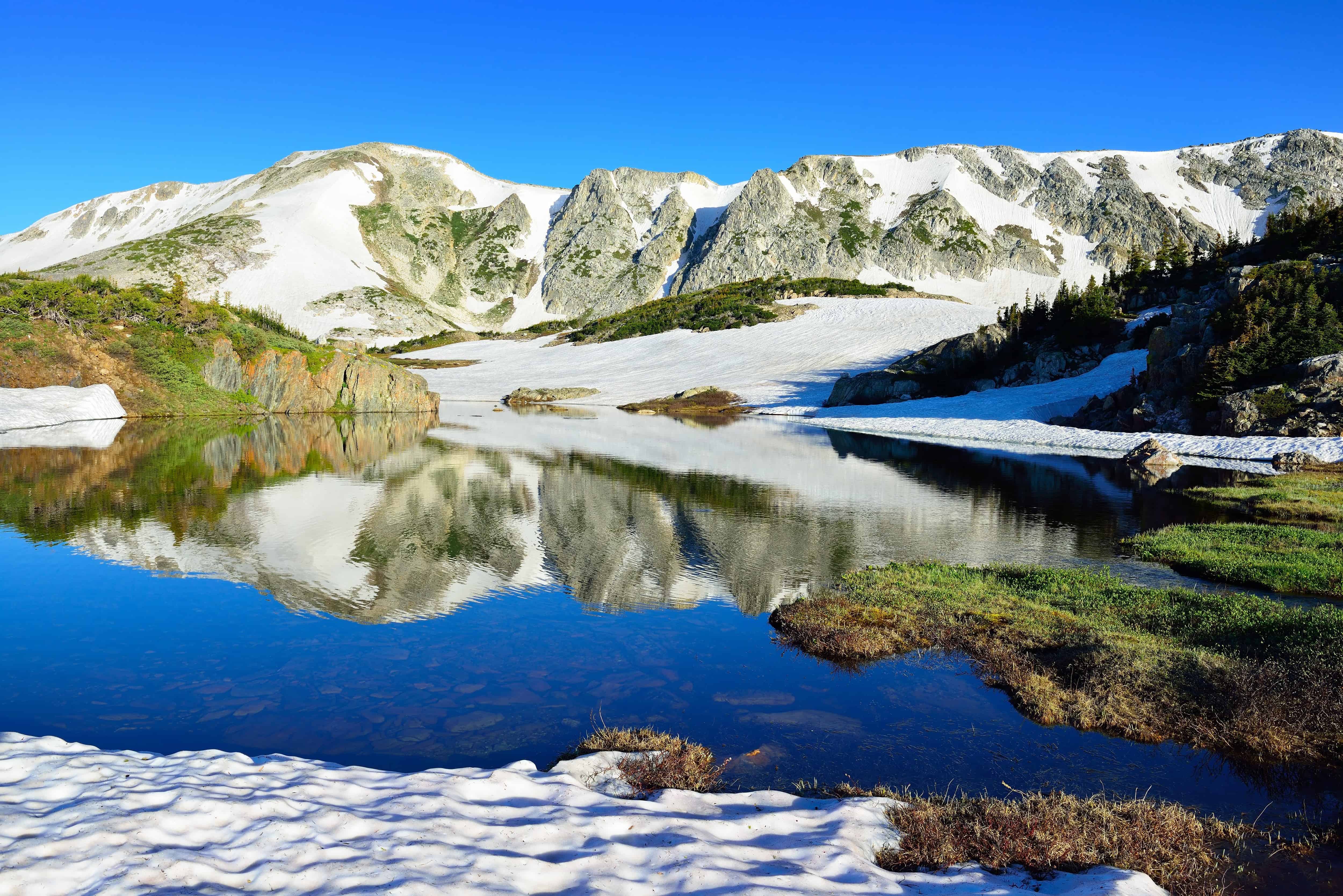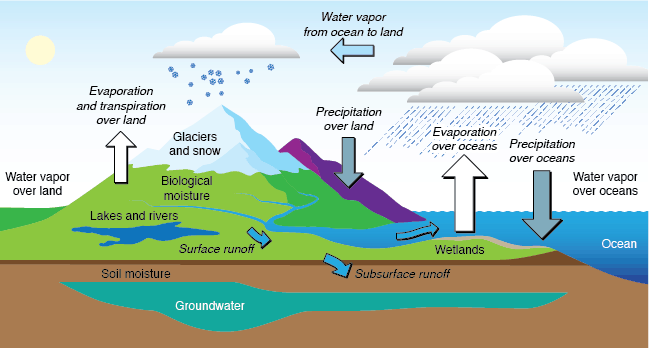
It can change its intensity over time, but the hydrologic cycle does not stop, and each part of the cycle is interconnected. As described by the U.S. Geological Survey,1United States Geological Survey, “The Water Cycle,” USGS Water Science School, May 2, 2016, accessed December 31, 2014, link.
“Earth’s water is always in movement, and the natural water cycle, also known as the hydrologic cycle, describes the continuous movement of water on, above, and below the surface of the Earth. Water is always changing states between liquid, vapor, and ice, with these processes happening in the blink of an eye and over millions of years.”
The hydrologic cycle includes major fluxes and volumes of water. The largest movements of water are evaporation and precipitation over the ocean. Other exchanges include significant transport of water vapor in the atmosphere, rainfall and snowfall over land, and other fluxes in the form of runoff, stream flow, and evapotranspiration, which is the evaporation of water through photosynthetic activity from the growth of plants. Earth has an abundance of water, but the purity, salinity, and availability differ greatly over time and place. The image of the hydrologic cycle is a depiction of water abundance, but converting, transporting, and purifying water to meet human needs requires energy.

Solar energy is the key force driving the hydrologic cycle.2 Weston A. Hermann, “Quantifying global exergy resources,” Energy 31 (2006): 1685-1702, accessed August 26, 2016, doi: 10.1016/j.energy.2005.09.006. Evaporating water consumes about half of Earth’s surface’s incident solar radiation.3Vaclav Smil, Energy: A Beginner’s Guide (London: Oneworld Publications, 2006). Essentially, the sun acts as a massive water pump, elevating water into the atmosphere. Gravity pulls that water back to Earth as snow and rain. As water rolls back down to the oceans, we harness it for power, agriculture, drinking, and many other purposes.
In addition to the movement of water from one location and form to another, there are also massive reservoirs of water in oceans; in aquifers, ice, and permanent snow cover; in permafrost (frozen water in the soil); in rivers, lakes, and swamps; in the atmosphere; and within living organisms. The world has plenty of water, but it’s not always available where we want it and in the form we need it.
| Water Source | Water Volume (mi3) | Water Volume (km3) | % of Fresh Water | % of Total Water |
|---|---|---|---|---|
| Oceans, Seas & Bays | 321,000,000 | 1,338,000,000 | — | 96.5 |
| Ice Caps, Glaciers & Permanent Snow | 5,773,000 | 24,064,000 | 68.6 | 1.74 |
| Groundwater Fresh Saline | 5,614,000 2,526,000 3,088,000 | 23,400,000 10,530,000 12,870,000 | — 30.1 — | 1.7 0.76 0.93 |
| Soil Moisture | 3,959 | 16,500 | 0.05 | 0.001 |
| Ground Ice & Permafrost | 71,970 | 300,000 | 0.86 | 0.022 |
| Lakes Fresh Saline | 42,320 21,830 20,490 | 176,400 91,000 85,400 | — 0.26 — | 0.013 0.007 0.007 |
| Atmosphere | 3,095 | 12,900 | 0.04 | 0.001 |
| Swamp Water | 2,752 | 11,470 | 0.03 | 0.0008 |
| Rivers | 509 | 2,120 | 0.006 | 0.0002 |
| Biological Water | 269 | 1,120 | 0.003 | 0.0001 |
| Total Water in the Hydrosphere | 1,386,000,000 | — | 100 | |
| Total Fresh Water | 35,030 | 100 | — |
The global distribution of water among types (saline and fresh) and locations shows that only a small fraction is easily accessible, fresh surface water.4Igor Shiklomanov and John C. Rodda, eds., “World Water Resources at the Beginning of the 21st Century,” International Hydrology Series (Cambridge: Cambridge University Press, 2003), referencing data from Igor Shiklomanov, “World fresh water resources,” in Water in Crisis: A Guide to the World’s Fresh Water Resources, ed. Peter H. Gleick (Oxford: Oxford University Press, 1993); and United States Geological Survey, “The Water Cycle.”
Image Credits: Alexey Kamenskiy/Shutterstock.com; Jeffrey M. Phillips/Webber Energy Group.
Update your browser to view this website correctly.Update my browser now